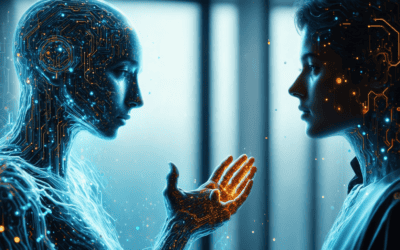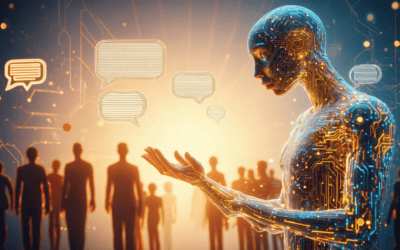In today’s digital landscape, the ability to build a chatbot from scratch has become an invaluable skill for developers and businesses alike. This comprehensive guide will walk you through the essential steps and considerations involved in creating a chatbot, whether you’re a seasoned programmer or a curious beginner. We will explore fundamental questions such as, Can you create a chatbot from scratch? and How hard is it to build a chatbot?, while diving into the key technologies and tools that empower you to build chatbots effectively. From understanding the basics of chatbot development to the intricacies of coding in Python and JavaScript, this article will provide you with the insights needed to embark on your journey of building a chatbot. Additionally, we will discuss the costs associated with chatbot creation, the skills required, and monetization strategies, ensuring you have a well-rounded understanding of the chatbot ecosystem. Get ready to unlock the potential of AI and learn how to build a chatbot that meets your unique needs!
“`html
Can you create a chatbot from scratch?
Understanding the Basics of Chatbots
Creating a chatbot from scratch can be a rewarding endeavor, allowing you to enhance user engagement and streamline customer interactions. A chatbot is a software application designed to simulate human conversation through text or voice interactions. They can be integrated into various platforms, including websites, messaging apps, and social media, to provide automated responses and assist users in real-time.
Before diving into the technical aspects, it’s essential to understand the fundamental components of chatbots:
- Natural Language Processing (NLP): This technology enables chatbots to understand and interpret human language, making interactions more intuitive.
- Machine Learning: Many chatbots utilize machine learning algorithms to improve their responses over time based on user interactions.
- Integration Capabilities: Chatbots can connect with various APIs and services, allowing them to pull in data and provide more personalized responses.
Key Technologies for Building Chatbots
To successfully build chatbots, you’ll need to familiarize yourself with several key technologies and platforms. Here’s a step-by-step guide to help you create your own chatbot effectively:
- Define the Purpose and Goals
- Identify the specific problems your chatbot will solve.
- Determine the target audience and their needs.
- Set measurable goals, such as reducing response time or increasing user satisfaction.
- Choose the Right Platform
- Select a development platform that suits your technical skills and project requirements. Popular options include:
- Dialogflow: A Google-owned platform that uses natural language processing (NLP) to create conversational interfaces.
- Microsoft Bot Framework: Offers a comprehensive set of tools for building and deploying chatbots.
- Rasa: An open-source framework that provides flexibility and control over your chatbot’s functionality.
- Select a development platform that suits your technical skills and project requirements. Popular options include:
- Design the Conversation Flow
- Map out the user journey and create a flowchart of potential interactions.
- Use tools like Lucidchart or Miro to visualize the conversation paths.
- Ensure the flow is intuitive and addresses user queries effectively.
- Develop the Chatbot
- Utilize programming languages such as Python or JavaScript, or leverage no-code platforms for simpler implementations.
- Implement NLP capabilities to enhance understanding of user inputs.
- Integrate APIs to connect your chatbot with external services, such as databases or third-party applications.
- Test and Iterate
- Conduct thorough testing to identify bugs and improve user experience.
- Gather feedback from real users and make necessary adjustments.
- Use A/B testing to compare different versions of your chatbot and optimize performance.
- Deploy and Monitor
- Launch your chatbot on your website or messaging platforms like Facebook Messenger or WhatsApp.
- Monitor interactions and analyze user data to refine responses and improve functionality.
- Regularly update the chatbot to incorporate new features and address evolving user needs.
- Promote Your Chatbot
- Use social media, email marketing, and your website to inform users about your new chatbot.
- Encourage users to interact with the bot and provide feedback for continuous improvement.
By following these steps, you can create a functional and engaging chatbot that meets the needs of your users. For further reading, consider exploring resources from Chatbots Magazine and Towards Data Science for the latest trends and methodologies in chatbot development.
“`

How Much Does It Cost to Build a Chatbot?
The cost of building a chatbot can vary significantly based on several factors, including the complexity of the chatbot, the technology used, and the development approach. Here’s a breakdown of the typical pricing structures:
Factors Influencing the Cost of Building Chatbots
1. Custom Development: For fully customized chatbots, the cost generally ranges from $75,000 to $150,000 or more. This pricing reflects the extensive development time, design, and integration required to create a tailored solution that meets specific business needs. Factors influencing this cost include the chatbot’s functionality (e.g., natural language processing, machine learning capabilities), integration with existing systems, and ongoing maintenance.
2. Chatbot as a Service (CaaS): CaaS solutions provide a more affordable entry point, with prices starting as low as $5 to $50 per month for basic functionalities. However, these solutions often come with limitations in customization and scalability. Popular CaaS platforms include Dialogflow, Chatfuel, and ManyChat, which offer varying pricing tiers based on features and usage.
3. Hybrid Solutions: Some businesses opt for a hybrid approach, combining custom development with CaaS platforms. This can range from $20,000 to $100,000, depending on the level of customization and the specific features required.
4. Ongoing Costs: Beyond initial development, consider ongoing costs such as hosting, maintenance, updates, and customer support, which can add an additional 10-20% of the initial development cost annually.
5. Industry-Specific Considerations: Industries such as healthcare, finance, and e-commerce may incur higher costs due to regulatory compliance and the need for advanced security features.
For more detailed insights and case studies on chatbot pricing, refer to resources like Master of Code and Chatbots Magazine, which provide comprehensive analyses of market trends and pricing models.
Free Resources for Creating a Chatbot
If you’re looking to build a chatbot from scratch without incurring high costs, there are several free resources available that can help you get started:
- Messenger Bot Tutorials – A collection of guides and tutorials to help you understand the basics of chatbot development.
- Brain Pod AI – Offers a demo and resources for creating AI chatbots with multilingual support.
- Brain Pod AI Help Center – A comprehensive resource for troubleshooting and learning more about AI chatbot functionalities.
- Quick Setup Guide – Learn how to set up your first AI chatbot in under 10 minutes.
Utilizing these resources can significantly reduce the cost of creating a chatbot while providing you with the necessary knowledge and tools to succeed.
Can anyone create a chatbot?
Creating a chatbot has become more accessible than ever, allowing individuals from various backgrounds to engage in building chatbots. Whether you’re a seasoned developer or a complete novice, the tools and resources available today make it possible for anyone to build a chatbot from scratch. In this section, we will explore the essential skills required for building a chatbot and the tools that can assist you in this journey.
Skills Required for Building a Chatbot
While you don’t need to be a programming expert to create a chatbot, having a basic understanding of certain skills can significantly enhance your development process. Here are some key skills that can be beneficial:
- Basic Programming Knowledge: Familiarity with programming languages such as Python or JavaScript is advantageous, especially if you’re looking to build chatbots that require custom functionalities. For instance, how to build a chatbot in Python can be a great starting point.
- Understanding of Natural Language Processing (NLP): Knowledge of NLP is crucial for creating chatbots that can understand and respond to user inputs effectively. Tools like Rasa or the Microsoft Bot Framework can help you implement NLP features.
- Design Skills: Designing a user-friendly conversation flow is essential. You should be able to visualize how users will interact with your chatbot to ensure a smooth experience.
- Analytical Skills: After launching your chatbot, analyzing user interactions and feedback is vital for continuous improvement. This will help you refine your chatbot’s responses and functionalities over time.
Tools to Help You Build a Chatbot
There are numerous platforms and tools available that simplify the process of creating a chatbot. Here are some popular options:
- Botpress: An open-source platform that allows for extensive customization, making it ideal for developers looking to build chatbots from scratch.
- Dialogflow: Google’s natural language processing tool that integrates easily with various applications, perfect for those wanting to enhance their chatbot’s conversational abilities.
- Chatfuel: This platform is particularly user-friendly for building chatbots on Facebook Messenger without any coding experience.
- Brain Pod AI: A versatile tool that offers a range of AI services, including chatbot development. You can explore their offerings at Brain Pod AI.
By leveraging these tools and developing the necessary skills, anyone can embark on the journey of building a chatbot. For more insights on chatbot development, consider checking out our chatbot tutorials that guide you through various aspects of this exciting field.
How to Create Your Own AI Like ChatGPT?
Creating your own AI like ChatGPT involves several critical steps that require a solid understanding of natural language processing (NLP) and machine learning. Below is a comprehensive guide to help you develop an outstanding AI chatbot.
Overview of AI Chatbot Development
To build a chatbot from scratch, you need to focus on several key areas, including selecting the right NLP framework, preparing your dataset, and training your model effectively. Here’s a detailed breakdown:
- Step 1: Select an NLP Framework
Choose a robust NLP framework that suits your needs. Popular options include TensorFlow, PyTorch, and Hugging Face’s Transformers library. These frameworks provide pre-built models and tools for building conversational agents. - Step 2: Dataset Preparation
Gather a diverse and extensive dataset to train your AI. This could include conversational data, books, articles, and other text sources. Ensure your dataset is cleaned and preprocessed to remove noise and irrelevant information. Consider using datasets like the OpenAI GPT-3 dataset or the Cornell Movie Dialogs Corpus for training. - Step 3: Training Your Chatbot
Utilize transfer learning to train your model on the prepared dataset. Start with a pre-trained model (like GPT-2 or GPT-3) and fine-tune it on your specific dataset. This approach significantly reduces training time and improves performance. Monitor metrics such as perplexity and accuracy during training to evaluate your model’s effectiveness. - Step 4: Fine-Tuning Your Chatbot
After initial training, fine-tune your model to enhance its conversational abilities. This can involve adjusting hyperparameters, implementing reinforcement learning from human feedback (RLHF), and conducting iterative testing. Aim for a balance between creativity and coherence in responses. - Step 5: Integrate Your Chatbot into an Interface
Develop a user-friendly interface for your chatbot. This could be a web application, mobile app, or integration with messaging platforms like Slack or Discord. Ensure the interface allows for seamless interaction and provides users with a smooth experience. - Step 6: Continuous Improvement and Updates
Regularly update your chatbot with new data and retrain it to improve its performance. Monitor user interactions to identify areas for enhancement and incorporate user feedback to refine responses. - Step 7: Ethical Considerations and Compliance
Ensure your AI adheres to ethical guidelines and data privacy regulations. Implement measures to prevent the generation of harmful or biased content. Familiarize yourself with guidelines from organizations like the Partnership on AI and the AI Ethics Guidelines from the European Commission.
By following these steps and leveraging the latest advancements in AI and NLP, you can create a sophisticated chatbot similar to ChatGPT that meets user needs effectively. For further reading, consider resources such as Brain Pod AI, which offers tools and insights into AI development.
Steps to Create an AI Chatbot from Scratch
To create a chatbot from scratch, you should focus on the following steps:
- Start by selecting an appropriate NLP framework that aligns with your project goals.
- Prepare a comprehensive dataset that reflects the type of conversations your chatbot will handle.
- Train your model using transfer learning techniques to enhance efficiency.
- Fine-tune your chatbot to improve its conversational skills and user engagement.
- Integrate the chatbot into a user-friendly interface for optimal interaction.
- Continuously update and improve your chatbot based on user feedback and new data.
- Adhere to ethical guidelines to ensure responsible AI usage.
By mastering these steps, you will be well on your way to building chatbots that can effectively engage users and provide valuable interactions.

How Hard Is It to Build a Chatbot?
Building a chatbot can range from straightforward to complex, depending on your goals and the technology you choose. Understanding the challenges involved is crucial for anyone looking to build a chatbot from scratch. Here’s a comprehensive guide to understanding the process:
Common Challenges in Building Chatbots
When embarking on the journey of creating a chatbot, several challenges may arise:
- Understanding Chatbot Types: There are two primary types of chatbots. Rule-Based Chatbots follow predefined rules and are easier to build, making them suitable for simple tasks like FAQs and basic customer support. In contrast, AI-Powered Chatbots utilize machine learning and natural language processing (NLP) to understand and respond to user queries more effectively, requiring more technical knowledge and resources.
- Choosing the Right Platform: Selecting the appropriate platform can be daunting. No-Code Platforms like Chatfuel and ManyChat allow users to create chatbots without programming skills, offering drag-and-drop interfaces and templates. However, for businesses with specific needs, custom development using platforms like Microsoft Bot Framework or Google Dialogflow may be necessary, which requires programming knowledge.
- Defining Objectives: Clearly outlining what you want your chatbot to achieve is essential. Whether it’s for customer support or lead generation, having defined goals will guide the development process.
Simplifying the Chatbot Development Process
To overcome the challenges of building a chatbot, consider the following steps to simplify the development process:
- Design Conversation Flow: Map out how interactions should progress. Anticipate user questions and design appropriate responses to create a seamless experience.
- Integrate APIs: For advanced functionalities, integrating third-party APIs can enhance your chatbot’s capabilities, such as payment processing or CRM integration.
- Test and Iterate: Launch a beta version of your chatbot, gather user feedback, and continuously improve based on real interactions. This iterative process is vital for refining the user experience.
Additionally, leveraging resources such as online courses on platforms like Coursera and Udemy can provide valuable insights into how to create a chatbot effectively. Engaging with communities on GitHub and Stack Overflow can also offer support and troubleshooting advice.
Is Chatbot Profitable?
Yes, chatbots can be highly profitable for businesses across various industries. Here are several ways in which chatbots can generate revenue:
Monetization Strategies for Chatbots
1. Product Recommendations: Chatbots can analyze user behavior and preferences to suggest related products or services, effectively increasing the average transaction value. According to a study by Juniper Research, chatbots are expected to save businesses over $8 billion annually by 2022 through improved customer service and sales efficiency.
2. 24/7 Customer Support: By providing round-the-clock assistance, chatbots enhance customer satisfaction and retention. This constant availability can lead to increased sales opportunities, as customers can receive immediate responses to their inquiries at any time.
3. Lead Generation: Chatbots can engage website visitors and collect valuable information, qualifying leads before passing them to sales teams. A report from Drift indicates that businesses using chatbots for lead generation see a 30% increase in conversion rates.
4. Cost Reduction: Implementing chatbots can significantly lower operational costs by automating routine tasks and reducing the need for extensive customer service teams. According to IBM, businesses can save up to 30% on customer support costs by utilizing AI-driven chatbots.
5. Enhanced User Experience: By providing personalized interactions and quick resolutions to queries, chatbots improve the overall user experience. A positive experience can lead to repeat purchases and customer loyalty, which are crucial for long-term profitability.
6. Integration with E-commerce Platforms: Many chatbots can be integrated with e-commerce platforms, enabling seamless transactions directly within the chat interface. This convenience can lead to higher conversion rates, as customers can complete purchases without navigating away from the chat.
In conclusion, chatbots not only streamline operations but also create numerous revenue-generating opportunities, making them a valuable asset for businesses looking to enhance profitability. For further insights, refer to sources such as Juniper Research and IBM‘s studies on chatbot efficiency and cost savings.
Case Studies of Successful Chatbot Implementations
Numerous companies have successfully integrated chatbots into their operations, showcasing their profitability. For instance, Zendesk has leveraged chatbots to enhance customer service, resulting in improved response times and customer satisfaction. Similarly, Shopify utilizes chatbots to assist merchants in managing their stores, leading to increased sales and customer engagement.
Additionally, businesses like Sephora have implemented chatbots for personalized product recommendations, significantly boosting their sales figures. These examples illustrate how effective chatbot strategies can lead to substantial financial benefits and improved customer experiences.
For more insights on chatbot implementations, you can explore this article that discusses various successful chatbot applications across different industries.
How to build a chatbot from scratch in Python?
Building a chatbot from scratch in Python is an exciting venture that allows you to harness the power of artificial intelligence and natural language processing. Python is a preferred language for many developers due to its simplicity and the vast array of libraries available for chatbot development. Here’s a step-by-step guide to help you get started.
Step-by-Step Guide to Building a Chatbot in Python
1. Define the Purpose: Before diving into coding, clarify what you want your chatbot to achieve. Is it for customer support, lead generation, or just for fun? Understanding the purpose will guide your design and functionality.
2. Set Up Your Environment: Ensure you have Python installed on your machine. You can download it from the official Python website. Additionally, consider using an IDE like PyCharm or Visual Studio Code for a better coding experience.
3. Choose a Framework: There are several frameworks available for building chatbots in Python, such as Rasa, Microsoft Bot Framework, and ChatScript. Rasa is particularly popular for its flexibility and ease of use.
4. Implement Natural Language Processing (NLP): Use libraries like spaCy or NLTK to process user inputs. These libraries help in understanding and generating human-like responses.
5. Develop the Chatbot Logic: Create the conversation flow and logic. This involves defining intents, entities, and responses. You can use a simple if-else structure or more complex state management depending on your needs.
6. Test Your Chatbot: Testing is crucial. Use various inputs to see how your chatbot responds. This will help you identify areas for improvement.
7. Deploy Your Chatbot: Once satisfied with the performance, deploy your chatbot on platforms like Facebook Messenger, Slack, or your website. You can use tools like Messenger Bot for easy integration.
Best Practices for Creating a Chatbot in Python
To ensure your chatbot is effective and user-friendly, consider the following best practices:
- Keep It Simple: Start with basic functionalities and gradually add more features. This approach helps in managing complexity and improving user experience.
- Use Clear Language: Ensure your chatbot communicates in a clear and concise manner. Avoid jargon unless necessary.
- Incorporate Feedback: Allow users to provide feedback on their experience. This information is invaluable for making improvements.
- Monitor Performance: Use analytics to track how users interact with your chatbot. This data can help you refine responses and enhance engagement.
- Stay Updated: Technology and user expectations evolve. Regularly update your chatbot to incorporate new features and improvements.
By following these steps and best practices, you can successfully build a chatbot from scratch in Python that meets your specific needs and enhances user interaction.




